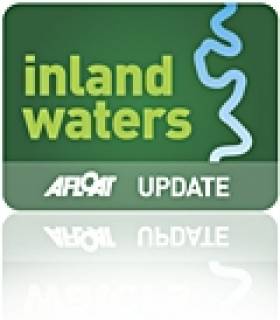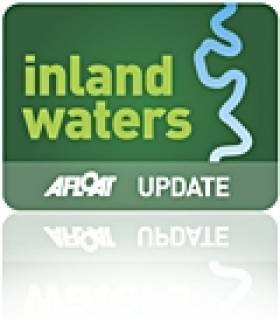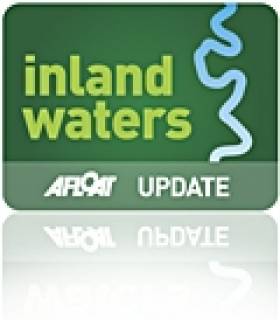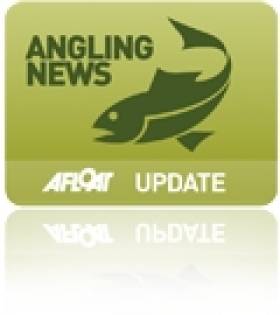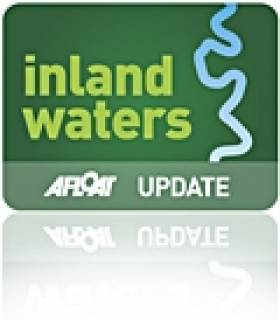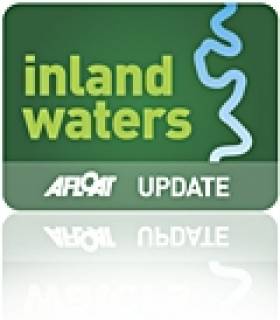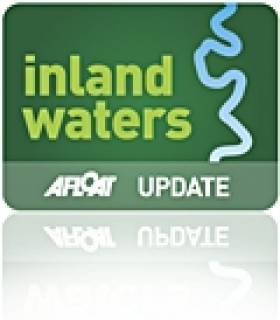Displaying items by tag: inland waterways
IWAI Fears New Bye-Laws Will 'Kill Off' Boating On Canals
#Canals - The Inland Waterways Association of Ireland (IWAI) has lambasted what it sees as an attempt to kill off "200 years of activity" on Ireland's canals via proposed new bye-laws.
Last week Afloat.ie reported on the launch of the public consultation on changes to the Draft Canals Act 1986 (Amended) Bye-Laws that cover the Grand Canal, Royal Canal and Barrow Navigation, which closes in less than a fortnight on 3 February.
At a recent meeting of the association to discuss the proposed regulation changes, IWAI president Carmel Meegan spoke out against the imposition of "high charges" to boat traffic that would drive waterway users away.
"The proposed bye-laws do not put user requirements, tourism development and local communities at the centre of the regulations," she said at the meeting in Naas last Saturday 18 January.
In a statement, the IWAI emphasised that the proposed new boat-hostile bye-laws "are a major threat to the community economic gain of boat travel" in the canals, and pointed out that access to the 'Green & Silver" tourism route on the Grand and Royal Canal, the Shannon and Dublin waterways "is also in jeopardy".
It added: "The boating community is not averse to appropriate management, facility provision and access to waterways. But boats are key attractions, as the lifeblood of the navigators, and need to be welcomed."
In addition, the IWAI bemoaned the short consultation period of just 21 working days for the bye-law proposals, compared to the longer consolation for the Waterways Ireland draft Corporate Plan 2014-2016 that runs till 31 March.
The association urges its members to get involved in the consultation before the closing date on 3 February.
Fallen Tree Blocks Royal Canal's Richmond Harbour
MARINE NOTICE
No 4 of 2014
Shannon Navigation & Royal Canal
Clondara / Richmond Harbour
Waterways Ireland wishes to advise masters that a large tree has fallen across the navigation and is presently obstructing the entrance to Richmond Harbour and the Camlin jetties.
A further marine notice will issue when the navigation has been cleared.
Shannon Navigation Lough Derg, Red Porthand Buoy off Station
MARINE NOTICE
No 3 of 2014
Shannon Navigation
Lough Derg
Red Porthand Buoy Off Station
Waterways Ireland has been advised that a red porthand buoy has been sighted grounded near Tinker Point on the western tip of Illaunmore island. Its previous position has yet to be identified.
Masters are requested to navigate with due caution in this area of Lough Derg until the buoy has been repositioned.
Lough Neagh Report On Shelf As Public Ownership Plans Stall
#LoughNeagh - The Belfast Telegraph reveals that a report by a special working group into the future of Lough Neagh has sat on the shelf at Stormont for almost 12 months - and it's feared that its recommendations will never be made public.
The report was commissioned as part of plans in early 2012 by the NI Legislative Assembly to take the largest inland lake in the island of Ireland - which supplies nearly half of Northern Ireland's drinking water - into full public ownership.
It's not commonly known that Lough Neagh is owned by the Earl of Shaftesbury, though the water within it is public property.
The 12th and present Earl of Shaftesbury, philanthropist and endurance athlete Nick Ashley-Cooper, recently met with MLAs to discuss the stalled progress on taking the lough public.
Responsibility for various aspects of the lough fall on different departments within Stormont, which may explain why one MLA believes the report "may never see the light of day".
The Belfast Telegraph has much more on the story HERE.
IFI Opens State Fisheries Tender Process for 2014
#Angling - The tender process for State fisheries under the auspices of Inland Fisheries Ireland (IFI) for 2014 is now open.
A list of all available fisheries on Ireland's inland waterways is available to download as a PDF file HERE.
Anyone wishing to tender for one or more fisheries should fill out the tender application form (available HERE) and send by post, in an envelope marked TENDER APPLICATION, to:
Justine Barrett,
Business Development,
Inland Fisheries Ireland,
Swords Business Campus,
Swords, Co Dublin
If your angling club is interested in a longer-term licence, please fill out the relevant section on your form and IFi will get in touch. However, please tender the ‘per year’ rate.
Queries relating to State fisheries or the 2014 tender process should be directed to Justine Barrett at [email protected] or 01 884 2600.
Tenders will only be accepted up until 30 November 2013.
In addition, all clubs who held a licence on a State fishery or fisheries during the 2013 season will need to fill out an End of Year Report Form and return it to IFI Swords at the above address by the same date (it may be posted together with a tender application).
End of Year Report Forms have all been sent out to clubs, but a digital version if required is available HERE.
Waterways Ireland Event Sponsorship Programme Opens
#Waterways - Waterways Ireland has opened its 2014 Sponsorship Programme for events on major inland waterways throughout the island of Ireland.
The programme is designed to support events taking place along the Lower Bann Navigation, the Erne System, the Shannon-Erne Waterway, the Shannon Navigation, the Barrow Navigation, the Grand Canal and the Royal Canal.
Taking place annually for the past eight years, the Waterways Ireland Sponsorship Programme has supported angling, canoeing, rowing, sailing and power-sports; competitions, learning experiences, historical and educational activities.
“Communities, clubs and associations in towns and villages, along rural waterways and in waterside urban centres, have participated in small and large events," says Éanna Rowe, head of marketing and communications with Waterways Ireland. "Huge numbers of people have been encouraged to experience something new about the waterways.
"The myriad events supported by Waterways Ireland play a significant role from both an economic and social standpoint in underpinning and supporting the waterway communities and recreational activity along Ireland’s inland waterways."
Applications are open to anyone wishing to run recreational waterway and waterside events. The application pack can be downloaded from the Waterways Ireland website HERE or is available by post by contacting Damien McWeeney at [email protected] or 071 96 50787.
The closing date for the receipt of completed applications is 4 December 2013 at 3pm. Terms and conditions apply.
Ireland's Waterways Inspire New Exhibition Of Art And Craft
#Waterways - ‘Water Land’, a free exhibition of sculpture and crafted objects by some of Ireland’s top artists and crafts people, will take place from 6-30 November 2013 in the Waterways Ireland Visitor Centre on the waters of Dublin’s Grand Canal Basin.
This exhibition brings together the heritage of the inland waterways with new work by contemporary artists and craft makers.
Curated by Sarah Ross, 'Water Land' will feature a selection of Ireland’s most well-known and recognised artists and crafts people, those resident in the Design Tower on Pearse Street, together with makers invited from across Ireland and abroad.
The Waterways Ireland Visitor Centre is a beautiful light filled space, with a sensation of floating on water it provides an excellent environment for displaying works of art and craft inspired by water.
The Design Tower, meanwhile, is located on the bank of the canal basin beside the Visitor Centre. Originally built in 1878 as a sugar refinery, it has been a creative hub of craft makers and artists for the last 30 years.
Throughout ‘Water Land’, the theme of water is broad and wide-ranging. Water helps anchor our history and our culture, and influences our architecture. As a valuable resource it is ever-present in our lives and is integral to our future. As an island country, we are never far from the presence of a water's edge, but at the same time we can be divided by its very presence.
The artists and makers use their experience with these themes for their inspiration in developing work in their individual media, whether that is precious metals, wood, clay, paper, glass and mixed media.
Among others, the exhibition will feature renowned jewellery designer Alan Ardiff, who reminds us of the recent summer heat wave with his diving bronze figure inspired by the daredevil swimmers in Grand Canal Basin.
Similarly, artist and sculptor Elizabeth O’Kane and bespoke jewellery designers Da Capo have produced exquisite work inspired by the movement and fluidity of water.
Referencing values associated with the use of water are fashion designer Róisín Gartland, whose work references the abuses in the fashion industry for the sake of western beauty, and adornment and ceramic artist Henry Pim, who reminds us of the depletion of water as a resource.
Despite the geographic divide between Connemara-based basketmaker Joe Hogan and the home of Swedish textile designer Liz Nilsson, both makers' work is inspired by the natural materials sourced from the waters edge.
This is further complemented by a series of sculptural forms created by Kildare’s internationally renowned woodturner Emmet Kane from reclaimed canal gates made from the hardwood called ekki.
Waterways Ireland, one of the six North/South Implementation Bodies established under the British Irish Agreement in 1999, has responsibility for the management, maintenance, development and restoration of inland navigable waterways principally for recreational purposes.
Due to both its historical significance and current value the element of water was seen as a very relevant theme to promote the work of over 20 artists and makers at the Waterways Ireland Visitor Centre.
‘Water Land’ is supported by Waterways Ireland and further funded by the Crafts Council of Ireland. Exhibition opening times for visitors are from Wednesday to Sunday, 10am to 6pm, and entry is free of charge.
For more information on the exhibition visit www.waterwaysireland.org and for more information on makers in the Design Tower visit www.thedesigntower.ie.
Galway Seminar Discusses Restoration of Western Waterways
#InlandWaterways - International speakers and policy experts are among the delegates in Galway today (23 October) for a seminar to discuss the restoration of inland waterways in Ireland's west region.
Galway Bay FM reports that the seminar is being hosted by the West Regional Authority under the LakeAdmin EU Project, which runs till December 2014 and aims to assess best practice in water management across 10 EU member states.
Inland Waterways Funding 'Will Deliver Core Targets' Despite Budget Cuts
#Waterways - The Department of Arts, Heritage and the Gaeltacht faces a whopping 7% cut in this week's Budget - but Minister Jimmy Deenihan promises Ireland's inland waterways will get the money they need to deliver "core targets".
In his departmental statement following the announcement of Tuesday's Budget for 2014, the minister confirmed that over €38 million will be allocated for North-South co-operation - which includes support for Waterways Ireland.
"I am committed to developing North-South co-operation within the broader arts, heritage and commemorative activities of the department as well as through the funding of North-South bodies," said Minister Deenihan.
"A provision of €38.3 million will be made available to support the two North-South implementation bodies, An Foras Teanga, comprising Foras na Gaeilge and the Ulster-Scots Agency, and Waterways Ireland.
"The provision will enable Waterways Ireland to deliver on its core activities and targets, which include keeping the waterways open for navigation during the main boating season and promoting increased use of the waterways resource for recreational purposes."
He added: "This expenditure should also assist in developing and promoting the waterways, attracting increased numbers of overseas visitors and stimulating business and regeneration in these areas."
In addition, the minister said "capital funding of almost €4 million will be made available to Waterways Ireland to facilitate the ongoing maintenance and restoration of Ireland's inland waterways, thereby increasing recreational access along the routes of waterways."
Meanwhile, Minister Deenihan confirmed that the lifting rail bridge over the Royal Canal below Newcomen Bridge will not be replaced with a drop lock.
The minister was responding to a Dáil question from Dublin Central independent TD Maureen O'Sullivan, who described the current facility - which requires canal users to contact Waterways Ireland a minimum of two weeks ahead of passage from the Docklands to the Royal Canal and vice versa - as "hostile" and "an impediment and discouragement to navigation on the Royal Canal".
However, the minister replied that "the option of introducing a drop lock to replace the need of the lifting bridge has been considered but not deemed viable due to the cost estimate involved."
The bridge was procured and installed by Waterways Ireland's predecessor body and is operated by Irish Rail on a request basis at the expense of Waterways Ireland.
Watermill Lodge Wins Waterways Ireland 'Taste of the Waterways' Award
#tasteofwaterways – Waterways Ireland was delighted to award, in conjunction with Georgina Campbell Awards the winner of the "Taste of the Waterways award 2014" to the Watermill Lodge in Lisnaskea, Co Fermanagh.
Hosted by Bord Bia in Dublin, these awards are presented annually in recognition of excellence in the Irish hospitality industry, with accolades across a range of categories, Reflecting the very best of these eateries along the waterways was Watermill Lodge. Dining at the Watermill is described as "Irish with a French twist", being owned by French Chef and fishing enthusiast Pascal Brissaud, and his Irish Partner Valerie Smith. The restaurant, in a striking thatched building full of character in a sylvan setting on the beautiful and expansive shores of Lough Erne, is complemented by exceptional accommodation and even a private jetty.
Éanna Rowe, Head of Marketing & Communications with Waterways Ireland congratulated the Watermill and indeed praised all the waterbased eateries for the enriching and fulfilling experiences they provide for visitors to Ireland's Inland Waterways.
The worthy winners included a number of establishments that feature in the "Taste of the Waterways Guide", produced by Waterways Ireland in conjunction with Georgina Campbell to highlight the best places to eat and drink along the waterways. Recently supplemented to incorporate things to See and Do, as well as Places to Stay, the guide is available free of charge from www.shopwaterwaysireland.org and is an essential ingredient in the recipe for a perfect visit to the waterways!



























